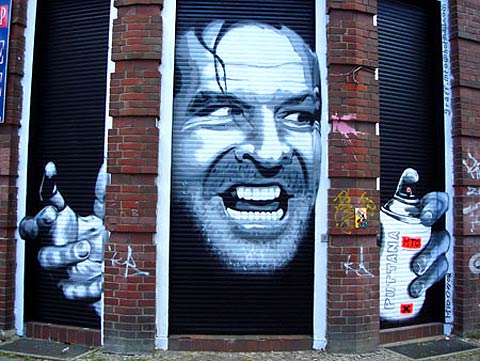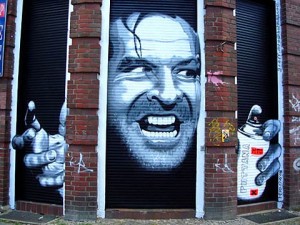With the recent Oscar nomination of Exit Through the Gift Shop, a comprehensive documentary about the graffiti art world and the developing trends within the counter-culture, specifically through the lens of Thierry Guetta, aka “Mr. Brainwash,” I believe a new reworking, or redefinition, needs to take place in order to understand what exactly is graffiti. It truly is an interesting and confusing argument, with some arguing that anything and everything put up on a wall is vandalism and can/should never be considered art, and others who believe that everything is art (hell, life is art to these people), and then there’s everyone in between who like to make distinguishing definitions between what is graffiti and what is vandalism. Who’s right? The debate carries on.
Look it up on the Internet, see all the random blog postings, news articles, and academic research devoted purely to the study and understanding of graffiti. It’s an exhausting process without any concrete answers. Some of the answers, in fact, are contradictory. But there are similar trends in how people like to view it. Most take polarizing figures within the graffiti culture and place them on a pedestal, like Shepard Fairey (the guy who did the Obama Hope posters and the Andre the Giant OBEY wheatpastings) and Banksy—possibly the most well-known name within graffiti right now, at least on an international level. You do have your more local names that are well known through the city, but Banksy and Fairey are the most recognized names, and, for the most part, have begun to legitimize the whole graffiti game, on part because of Exit Through the Gift Shop.
Yet still, people don’t seem to get it. Even Banksy, by the end of the film, expressed his discontent over how many people were commercializing his work, and thus destroying its entire purpose. This, in fact, is what the whole Post-Graffiti movement is about. It’s not necessarily some artistic movement within graffiti and those who practice the art form, but it’s purely commercial—as in, while the artist may create a piece in the style of what graffiti has become (which is generally illegal), the work is then repurposed when a viewer or art buyer spends money on it (thus making it legal and redefined).
While keeping that in mind, Post-Graffiti—its name and definition not really having any clear definition or origin itself—is an umbrella term used to encompass anything and everything that could be considered street art. A lot of people like to use John Fekner’s quote from the book Street Art: The Graffiti Revolution to define street art as “all art on the street that’s not graffiti” (i.e. art on the street that’s not illegal or vandalism). For one, John Fekner is not a good artist. He’s pretentious, uses tawdry definitions, and his art is too meretricious to be considered anything except a replication of what real graffiti artists do. There is, in fact, little difference between graffiti and street art, or Post-Graffiti, their methods being very similar. The legality is sometimes in question, but really the only difference is that street art is more expansive in its definition.
What is different, and what many people seem to be missing, is there’s a difference between vandalism and graffiti. Vandalism’s only purpose is the destruction of property and is generally malicious in its content. Graffiti, on the other hand, is an art form that’s purpose is to recreate and repurpose a piece of architecture in a rather perennial manner that happens to be considered by some (not all) to be a destruction of property. It’s all about intention and style. Most graffiti artists spend hours and hours throughout the night painting a wall, bridge, building, billboard, etc. etc. Vandalism is a quick and easy process of painting private property with absolutely no artistic merit.
Thus, what Post-Graffiti and graffiti achieve is almost the exact same: the expression of art in an urbanized environment. And while each individual artist has a different reason, purpose, and style in what they’re doing with their art, they do each share an essential quality of repurposing originally bland architecture that people run over without noticing until paint (be legal or not) covers it.
Let’s take the example of Banksy, since he’ll be the most identifiable and I won’t have to explain too much of what he does. Many of these news articles that I see state that Banksy is a street artist and is a part of the whole Post-Graffiti movement. At the same time, they state that street art, as opposed to graffiti, is legal and therefore has merits as being considered art. But I contend such mendacious assumptions. For one, while Banksy has done some work that has only been seen in a gallery, most of his work on the streets is illegal. He’s become famous for painting the West Bank, putting a makeshift blowup Guantanamo Bay prisoner in Disneyland, and generally terrorizing the streets with his absurd artwork in London, L.A., New York, etc. etc. Not once has any of this work been commissioned by some sort of private corporation or even ordained by the cities, and are thusly torn down hours after they are erected, despite the many hours that he spends doing each piece (both in concept and technique).
So, by the definition of these amateurish graffiti commentators, Banksy is not actually creating art, he’s just a vandal, despite popular believes that Banksy’s technical skills in his art form is without question good. And again, to bring the argument back to Post-graffiti being nothing but a commercial movement started by the consumer and not the artist, much of Banksy’s work was not created for the intention of being sold for the gross amounts of money that people are selling it for. Banksy, in essence, is the embodiment of the recalcitrant, rebellious soul that refuses to be pinned down by the rapacious consumer who needs to define the quality of everything by its monetary value.
You don’t actually have to know Banksy, or artists like him, to know that he (and they) would find it a disgusting representation of their art.
But considering the literature written within the past 50 or so years, it’s not surprising that those outsiders misunderstand the entirety of what modern graffiti’s purpose is. Which is understandable, because most artists that actually hone their skills in graffiti have absolutely no uniform ideals about what they’re doing, Some artists are purely putting out their names in this grass-root style of getting recognized. While other artists, some claim them to be real artistes (as pretentious as that sounds), who use the world as their canvas so that they can spread a message. And then there are just reasons for doing graffiti that span in between those two. None of it is the exact same, yet still commentators who’ve seen a few scrawling aerosol tags on a wall claim that they know the true reason behind why people do it and then write about the entirety of graffiti as if it is something upon which they’ve done extensive research. And still others refuse to see any merit within the art form and just dismiss it as vandalism.
I guess the best way to think about graffiti, though, and its counter-part, Post-Graffiti, is to consider some random buildings that have been abandoned or neglected, and think about its purpose. A lot of times these graffiti artists are merely taking buildings and bridges that are on a daily basis passed over without any consideration as to what went into their creation, and they paint them; they forcefully draw attention to their existence once again. And rather than just merely passing over it without second thought or glance, people pay attention. They pay attention to their community because of graffiti.
So, perhaps graffiti is vandalism. When considering the law to the letter (not the spirit) it certainly is, but I’ve seen shifting trends within the commentary of graffiti—how it’s thought about and what purpose it has for its community. And by continuing this dialogue, there is the possibility that we can arrive at a more informed understanding of what the movement actually means.
Graffiti v. Post-Graffiti: Words on a Wall,





Stained Oasis
2 Mar 2011Graffiti is not simply a maintenance problem, but a complex social problem as well. Graffiti vandalism is mainly caused by minors in the late-night or early morning hours. Some is the product of gang activity, and is used to identify territories, indicate associations or conflicts between gang members, or promote the sale of illegal drugs. The vast majority of the increase in graffiti vandalism is the result of “tagging,” which is committed by juveniles with the primary objective being peer recognition. Taggers are not necessarily gang members, and come from all neighborhoods of the city.
City of San Diego Graffiti Control Program http://www.sandiego.gov/graffiti/index.shtml.